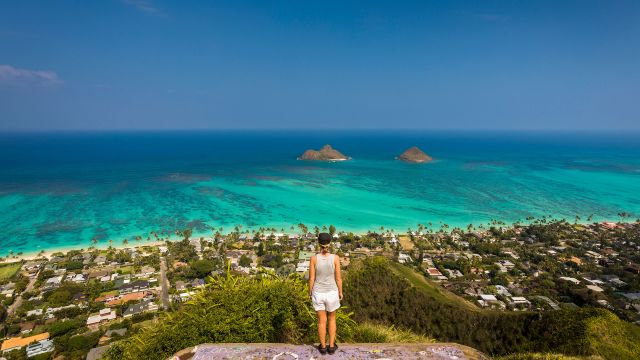Hawaii has long been ranked as one of the healthiest states in the country, but many residents struggle to stay active. The Department of Health and Human Services’ Physical Activity Guidelines for Americans recommends adults complete 150 to 300 minutes of moderate-intensity exercise, or 75 to 150 minutes of vigorous-intensity exercise weekly, in addition to strength training twice a week. That can seem intimidating, but the report also notes that any amount of physical activity is beneficial.
Walking is a great way to get moving, and hiking is a natural extension, especially given Hawaii’s tropical climate and volcanic terrain. There are hundreds of trails in the Aloha State, meaning that there is something for almost everyone, from keiki and kapuna to experienced pros.
Not sure how to get started? We spoke with Aaron Lowe, a Na Ala Hele Trails Specialist with the Department of Land and Natural Resources (DLNR) for hiking safety tips and ideas on how to get into hiking.
Start small
“You don't have to be a tourist to take a tour,” says Lowe. There are hiking tour companies throughout Hawaii that will take people through established trails. Trained guides are often very knowledgeable and can provide interesting insights about the trail’s history and native flora and fauna.
Lowe notes that tours can be good for individuals who may be intimidated about starting hiking. These guide-led hikes tend to be beginner-level which helps ease participants into the activity. “That's one idea people commonly don't really think about, because they think that those tours are for tourists, but they can actually be quite enjoyable for local people,” says Lowe.
If the cost or structured environment of a tour isn’t appealing to you, Lowe suggests starting with well-trafficked beginner hikes, such as the Makiki Valley loop in Honolulu. “What's good about it is there's a lot of people that are hiking up there from the hiking community. A lot of residents hike that loop once a day just for exercise.”
Stay safe
Safety is always a concern when hiking. Even well-maintained trails can be dangerous or remote. DLNR has a hiking safety brochure that gives guidance on how to prepare for a hike, what to bring and what to do in case of an emergency.
Whenever setting out for a hike, always check weather conditions in advance and look for trail closures. “We have to close trails sometimes if there's a hazard, or an accident,” says Lowe. For example, hikes such as the popular Manoa Falls on Oahu will be automatically closed for 48 hours following a flash flood warning in the area. Also, be sure to let someone know where you’ll be and don’t hike alone. Always dress appropriately as well with light layers to protect your skin from the sun, a hat and hiking boots.
Items to carry on a hike include:
- Water, at least two liters per hiker per day
- Cell phone, though not all hikes will have service
- Trail map, if available
- Brightly colored clothing for visibility
- Non-perishable snacks
- Backpack
- Sunscrxeen
- Insect repellent
- Whistle
- First aid kit
- Flashlight
- Watch
While you’re on the trail, always stay on the marked path. Side trails are not maintained and may pose risks. Keep an eye on the clock too to make sure you head in with plenty of time before sunset. In the case of an emergency, call 911. If there is no service, use your whistle and brightly colored clothes to signal to others who may also be out hiking.
Finding your next hike
Most of Hawaii’s trails are managed by DLNR, with the notable exceptions of Diamond Head, Koko Head, Makapuu Lighthouse, Aiea Loop and Kahana Valley, which are managed by State Parks or the City and County of Honolulu. All other officially maintained trails can be found on the DLNR website, which provides trail descriptions, special conditions, terrains, route descriptions, histories, plant and bird notes, trail tips, amenities and more for each of its hike.
In addition to government-sanctioned trails, Hawaii has many unofficial hikes that you may see on third-party websites. Generally, these hikes are not on maintained trails and can be highly dangerous, possibly even illegal. Lowe cautions against these trails: “They don't have signs. They don't have warnings. They don't have parking. And a lot of times there you're trespassing.” One famous example on Oahu is the Haku Stairs, or Stairway to Heaven. This hike is not maintained, has several dangerous sections and is only accessed by trespassing through private property. Lowe recommends sticking to trails on the DLNR website, or the five trails listed above that are otherwise maintained.
Protect our aina
As always in Hawaii, be respectful of nature. Hawaii is home to many unique species of flora and fauna as well as native birds. Avoid spreading pollens and seeds outside of their habitats by wearing clean boots in and whipping shoes off when you leave. Remember that some trails may pass by or through Native Hawaiian sacred sites so treat all trails with respect.






